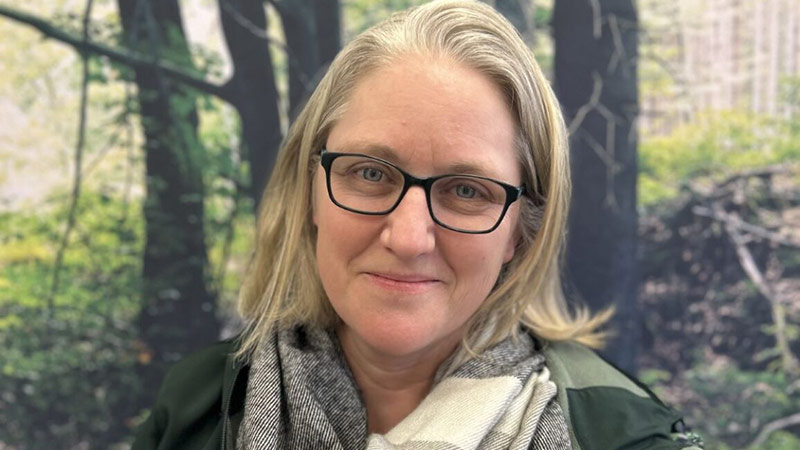Sustainability and climate change lenses emphasized by new forestry and environmental management dean
Author: Alex Graham
Posted on Mar 5, 2024
Category: UNB Fredericton

Dr. Michelle Gray is on a mission to change people’s perceptions about forestry.
“One of our biggest battles is ‘what is forestry’ and ‘what is forestry not,’ because it’s not about cutting down trees harder and faster. It is more about improving productivity, diversity and the overall resilience of forest ecosystems.”
Dr. Gray has just started her five-year term as dean of forestry and environmental management (ForEM) on the University of New Brunswick’s (UNB) Fredericton campus, but she has been in the role as acting dean since 2021.
Gray’s background is in biology and environmental science, having earned bachelor’s and master’s degrees from Trent University before completing her PhD at UNB. Working with Kelly Munkittrick, the then Canada Research Chair in Ecosystem Health Assessment, Gray‘s doctoral work was in the field of environmental biology.
“I studied the impact of row crop agriculture on fish populations in northern New Brunswick, essentially asking, ‘How does potato production affect fish populations?’”
It turns out, the largest impact on those populations was water temperature, and that can be related to trees, of all things.
“When you cut down trees in the riparian area (the area next to rivers or streams), there is less shading and the rivers can heat up.” she explained.
Since then, Gray has taken an active role in several different environmental science and forestry related initiatives in the province, including membership at the NB Advisory Board for the Atlantic Salmon Conservation Foundation, NB Watershed Management Working Group and the NB Protected Natural Areas Scientific Advisory Committee. She is currently serving as the director of the Canadian Rivers Institute.
Those early lessons are helping her set a course for the faculty in the years ahead.
“Sustainability plays an important role in both our undergraduate programs – forestry and environmental management,” Gray said. “Sustainability and climate change are the lenses through which we look at both of those fields.”
The faculty is about halfway through its strategic plan in which themes of sustainability, inclusion and research play a prominent role. The plan, which Gray helped develop in her role as acting dean, sets out ambitious metrics and aligns directly with the university’s goals outlined in UNB Toward 2030.
“It means when we go to start reporting on it, we can show exactly how much impact we’ve had on the various metrics which UNB set out.”
The plan outlines the faculty’s mission to become a world leader in “promoting the sustainable management of forests and the environment for future generations.”
Some of the other goals of the plan include developing more inclusive learning environments and incorporating Indigenous knowledges into existing curriculum; engaging in innovative learning and teaching pedagogies; and expanding ForEM online, micro-credential options and professional learning opportunities.
The plan also increases its focus on research by faculty and graduate students, with the overall goal of increasing the programs’ research profile on a national and international level.
In addition, Gray has recently welcomed two new faculty members that will help ForEM continue to strive towards the goals it has set for itself. Dr. Rafaella Mayrinck has joined as assistant professor of silviculture and Dr. Christopher Wong as assistant professor of remote sensing.
Gray’s appointment is also an important one for representation at UNB. In this role, Dr. Gray becomes the first woman in UNB history to be dean of ForEM.
“I think it’s significant for others in our faculty to see that,” she says of the new representation she brings to the position. “In the forestry field it’s definitely a little bit more male-dominated. For females to see that they are represented here, and that there are opportunities, I think is an important milestone.”
As for ForEM, Gray says it is ahead of its time in terms of the kind of learning experience the disciplines of forestry and environmental management can offer students.
“We have always spent a lot of time working on hands-on skills and learning opportunities,” she said. “We’ve been doing experiential learning forever and so now we’re just building upon that.”
She looks forward to welcoming undergraduate and graduate students to the faculty to learn and train together to help shape a future where our forests thrive, our rivers flow freely and our ecosystems flourish for generations to come.
